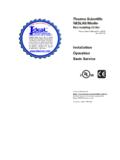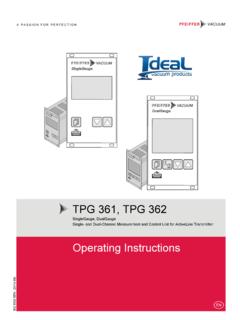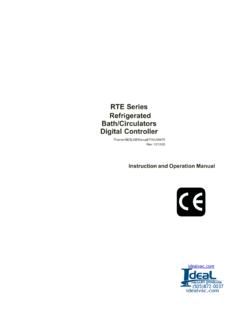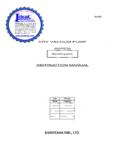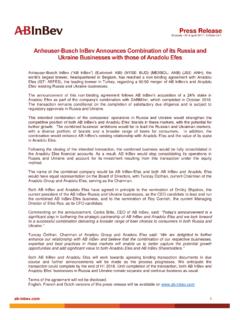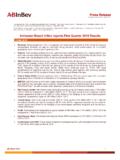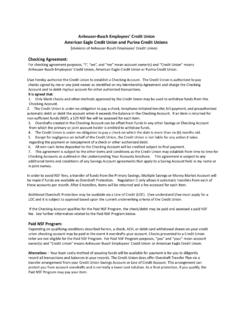Transcription of MATERIAL SAFETY DATA SHEET - Ideal Vac
1 MATERIAL SAFETY data SHEET . SECTION I - PRODUCT AND COMPANY IDENTIFICATION. Product/ MATERIAL : Busch R-530 Vacuum Oil Emergency Telephone No. Manufacturer: Busch, Inc. Chemtrec: (800) 424-9300. Address: 516 Viking Drive Non-emergency Telephone No. Virginia Beach, VA 23452 Busch, Inc. (757) 463-7800. SECTION II - PRODUCT/INGREDIENTS. Ingredients: Machine and bearing oil, highly refined petroleum oils, 100%. concentration by volume CAS No.: Proprietary, blend SECTION III - HAZARDS IDENTIFICATION AND TOXICOLOGICAL INFORMATION. Hazard Statement: No known immediate health or physical hazards. Appearance and Odor: Pale yellow liquid.
2 Slight hydrocarbon odor. NFPA Rating: Health = 0, Fire = 1, Reactivity = 0. Inhalation: Vapors (generated at high temperatures only) or oil mist may cause mild irritation of the nose, throat and respiratory tract. Eye and Skin Irritation: Generally, minimally irritating to eyes and skin. Prolonged and repeated contact may result in defatting/drying of skin causing various skin disorders such as dermatitis, folliculitis or oil acne. Ingestion: Generally, no more than slightly toxic if swallowed. Aggravated Medical Conditions: Pre-existing eye, skin and respiratory disorders may be aggravated by exposure to this product.
3 Acute Toxicity: Dermal LD50: > (Rat), OSHA classification: non-toxic. Oral LD50: > (Rat), OSHA classification: non-toxic. Carcinogenicity Classification: Machine & Bearing Oil NTP = no, IARC = not reviewed, ACGIH = no, OSHA = no SECTION IV - FIRST AID MEASURES. Inhalation: Remove victim to fresh air and provide oxygen if breathing is difficult. Seek medical attention. Eyes and Skin: Eye contamination, flush eyes with water. Skin contamination, remove contaminated clothing, wipe excess from skin, flush skin MSDS R-530 Page 1 of 4 Rev. 07/05. with water, wash with soap and water. If irritation occurs to eyes or skin, seek medical attention.
4 Ingestion: DO NOT INDUCE VOMITING! Generally, no treatment is necessary unless large quantities of product are ingested. Seek medical attention. Note to Physician: In general, emesis induction is unnecessary in high viscosity, low volatility products such as oils and greases. SECTION V - FIRE FIGHTING MEASURES. Flash Point: >385 F/> C (Cleveland Open Cup). Extinguishing Media: MATERIAL will float and can be re-ignited on surface of water. Use water fog, alcohol foam, dry chemical or carbon dioxide (CO2) to extinguish flames. Do not use a direct stream of water. Fire Fighting Instructions: MATERIAL will not burn unless preheated.
5 Do not enter confined space without full bunker gear (helmet with face shield, bunker coats, gloves and rubber boots), including a positive pressure, NIOSH approved, self-contained breathing apparatus. SECTION VI - ACCIDENTAL RELEASE MEASURES. Protective Measures: Not readily ignitable, but may burn. Wear appropriate personal protective equipment when cleaning up spills. Spill Management: For large spills, remove with vacuum truck or pump to storage/salvage vessels. For small spills, soak up residue with an absorbent such as clay, sand or other suitable MATERIAL . Place in non-leaking container; seal tightly for proper disposal.
6 Reporting: Product is covered by EPA's Comprehensive Environmental Response, Compensation and Liability Act (CERCLA) petroleum exclusion. Releases to air, land or water are not reportable under CERCLA (Superfund). Product is defined as oil under Section 311 of EPA's Clean Water Act (CWA). Spills into or leading to surface waters that cause a sheen must be reported to the National Response Center, 1-800-424-8802. SECTION VII - HANDLING AND STORAGE. Precautionary Measures: Wash with soap and water before eating, drinking, smoking, etc. Launder contaminated clothing before reuse. Properly dispose of contaminated leather articles that cannot be decontaminated.
7 Avoid heat, open flames and strong oxidizing agents. Use explosion-proof ventilation to prevent vapor accumulation. Ground all handling equipment to prevent sparking. Storage: Store in a cool, dry place with adequate ventilation. Keep away from open flames and high temperatures. MSDS R-530 Page 2 of 4 Rev. 07/05. Container Warnings: Keep containers closed when not in use. Containers can contain explosive vapors. Do not cut, drill, grind, weld or perform similar operations on or near containers. SECTION VIII - EXPOSURE CONTROLS/PERSONAL PROTECTION. Chemical: Limit TWA STEL. Oil mist, mineral: ACGIH TLV 5 mg/m3 10 mg/m3.
8 Oil mist, mineral: OSHA PEL 5 mg/m3. Exposure Controls: Adequate ventilation to control airborne concentrations below the exposure guidelines/limits. Personal protection: Personal protective equipment (PPE) selections vary based on potential exposure conditions such as handling practices, concentration and ventilation. Eye Protection: Chemical goggles or SAFETY glasses with side shields. Skin Protection: Use protective clothing chemically resistant to this MATERIAL . Depending on exposure conditions, gloves, boots, suits or other items may be advised. Consider factors such as job tasks, type of exposure and durability requirements when selecting PPE.
9 Generally, neoprene or nitrile rubber yields the best protection. Respiratory Protection: If engineering controls maintain airborne concentrations below the allowable exposure limits, no respirator is required. If exposure limits are exceeded, select a respirator in accordance with the requirements of the OSHA Respiratory Protection Standard, 29 CFR. SECTION IX - PHYSICAL AND CHEMICAL PROPERTIES. Appearance and Odor: Pale yellow liquid. Slight hydrocarbon odor. Substance Chemical Family: Lubricants Boiling Point: >550 F. Flash Point: >385 F (Cleveland Open Cup). Pour Point: 10 F - 20 F. Specific Gravity: SECTION X - REACTIVITY AND STABILITY.
10 Stability: Stable under normal conditions. Conditions to Avoid: Avoid heat and open flames. Materials to Avoid: Avoid strong oxidizing agents. Hazardous Decomposition Products: Dependent on combustion conditions. A complex mixture of airborne solids, liquids and gases will evolve when this MATERIAL undergoes pyrolysis or combustion. Carbon Monoxide, carbon dioxide and other unidentified organic compounds may be formed upon combustion. MSDS R-530 Page 3 of 4 Rev. 07/05. SECTION XI - ECOLOGOCAL CONSIDERATIONS. Environmental Impact Summary: No data available for this product. It is an oil and is persistent. It does not readily biodegrade and does not bioaccumulate.
